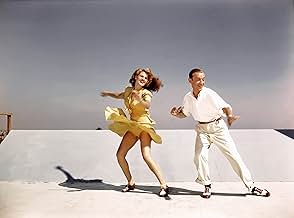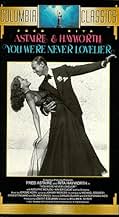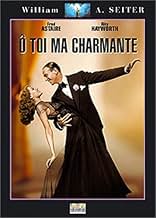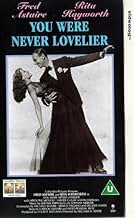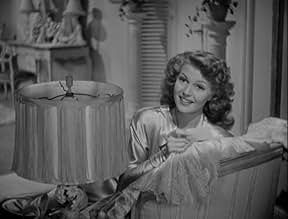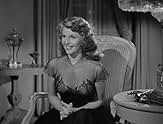NOTE IMDb
7,1/10
4,4 k
MA NOTE
À Buenos Aires, un propriétaire de cabaret, qui a décrété que ses filles devront se marier par ordre d'âge, permet à un danseur américain de se produire dans son club à la condition qu'il jo... Tout lireÀ Buenos Aires, un propriétaire de cabaret, qui a décrété que ses filles devront se marier par ordre d'âge, permet à un danseur américain de se produire dans son club à la condition qu'il joue le prétendant de sa deuxième fille aînée.À Buenos Aires, un propriétaire de cabaret, qui a décrété que ses filles devront se marier par ordre d'âge, permet à un danseur américain de se produire dans son club à la condition qu'il joue le prétendant de sa deuxième fille aînée.
- Réalisation
- Scénario
- Casting principal
- Nommé pour 3 Oscars
- 3 nominations au total
Kirk Alyn
- Julia's Groom
- (non crédité)
Desi Arnaz
- Band Singer
- (non crédité)
Larry Arnold
- Wedding Guest
- (non crédité)
William A. Boardway
- Wedding Guest
- (non crédité)
Stanley Brown
- Roddy - Cecy's Boyfriend
- (non crédité)
George Bunny
- Flower Man
- (non crédité)
James Carlisle
- Wedding Guest
- (non crédité)
Jack Chefe
- Nightclub Patron
- (non crédité)
Avis à la une
Pop quiz: Who was Fred Astaire's favorite female dancing partner? If your answer is the obvious one, Ginger Rogers, guess again. Cyd Charisse, Vera-Ellen, Judy Garland, Joan Leslie, Eleanor Powell? Still wrong. Surprisingly, Astaire long maintained that his favorite was none other than Rita Hayworth. Rita, he once said, could be taught a complicated piece of choreography in the morning and have it down pat after lunch! The two made a pair of films together, "You'll Never Get Rich" in 1941 and "You Were Never Lovelier" in '42. A look at Hayworth's work in the latter film will demonstrate what a remarkable learner she apparently was. She and Fred share several musical numbers here, including the moonlit garden waltz to "I'm Old Fashioned" and the remarkably high-spirited and dynamic "Shorty George," and the two do make a marvelous pair. As for the rest of the film, it is a typical Astaire comedy, replete with mistaken identities, concerning Rita's father, Adolphe Menjou, convincing Fred to impersonate the fictitious lover that he has devised for her. The viewer must wait almost 40 full minutes to see Fred dance in this one, but that wait is well repaid when Astaire explodes in a brash and frenetic audition number for ol' Adolphe. The film's script is bright and amusing, Xavier Cugat's orchestra adds colorful support, and Rita is at least as beautiful, if not more so, than in 1946's overrated "Gilda." Bottom line: This is no Fred & Ginger picture, but it sure does have its compensations...Rita Hayworth surely being one of them.
Eight out of ten seems an extravagant score for a fairly nonsensical bit of cotton-candy, but earned, if only for the muted elegance of the "I'm Old-fashioned" number, which is the absolute essence of romance. Although he always maintained a tactful evasiveness on the subject, I suspect Rita Hayworth may have been Fred's favourite partner. She, nee Cancino, was born into a (flamenco) dancing family, and like Astaire, danced with her whole body. While he, as is evident from the long roster of screen partners (including the late TV specials), obviously believed, with some justice, that he could transform any reasonably adequate dancer into what was required, he must have rejoiced, making this and their other joint movie, to work with a woman whose instincts were, uncoached, a match for his own. See it.
...and Fred Astaire was never as boyishly charming as he is here. This is a lovely, escapist, feel-good musical made in the early 40's to appease WW2-weary audiences. This is Rita and Fred's second (and final) outing after the surprise success of 'You'll Never Get Rich', and, while the first film was very enjoyable, this is an improvement on it's predecessor.
Hayworth shines as the girl who's not very interested in marriage until a 'secret admirer' and Fred Astaire come into the picture. She's very beautiful and glamorous in the role; the 'Cansino-to-Hayworth' transformation was going along nicely at the film's time of release. Astaire is always very appealing, and he does light comedy quite well. This hs a far sharper script than 'You'll Never Get Rich' and benefits from the non-wartime backdrop. Yes, the war was going on when Rita and Fred were making dancing magic, but you'd never know it from the happy little self-contained vacuum that Columbia creates for the pair in a story meant to be set in exotic South America.
I guess Rita, with her Latin roots, was the perfect choice for Maria, and she manages to outdo the master Astaire in the Latino-inspired dance routines. Her singing is dubbed, but Rita's dancing is sublime and her acting is very effective.
This film also has more memorable songs than the 1941 Astaire-Hayworth outing (I don't particularly like to compare, but it's hard not to), with 'You Were Never Lovelier', 'Shorty George' and 'I'm Old Fashioned' being great tunes. 'Shorty George' entranced me so much that I re-played the sequence on DVD three times before I moved forward in the film!
It doesn't have much of a plot, but we know that Astaire's musicals were always light on this factor so we can be forgiving. What it does have is a perfect, innocent sweetness that cannot possibly be recaptured today. From early scenes with Astaire trying to make conservation with a haughty Rita, to the final scene where the awkward yet lovable Fred arrives as Rita's 'knight in shining armor' on a white horse, 'You Were Never Lovelier' is just...well, lovely.
8/10.
Hayworth shines as the girl who's not very interested in marriage until a 'secret admirer' and Fred Astaire come into the picture. She's very beautiful and glamorous in the role; the 'Cansino-to-Hayworth' transformation was going along nicely at the film's time of release. Astaire is always very appealing, and he does light comedy quite well. This hs a far sharper script than 'You'll Never Get Rich' and benefits from the non-wartime backdrop. Yes, the war was going on when Rita and Fred were making dancing magic, but you'd never know it from the happy little self-contained vacuum that Columbia creates for the pair in a story meant to be set in exotic South America.
I guess Rita, with her Latin roots, was the perfect choice for Maria, and she manages to outdo the master Astaire in the Latino-inspired dance routines. Her singing is dubbed, but Rita's dancing is sublime and her acting is very effective.
This film also has more memorable songs than the 1941 Astaire-Hayworth outing (I don't particularly like to compare, but it's hard not to), with 'You Were Never Lovelier', 'Shorty George' and 'I'm Old Fashioned' being great tunes. 'Shorty George' entranced me so much that I re-played the sequence on DVD three times before I moved forward in the film!
It doesn't have much of a plot, but we know that Astaire's musicals were always light on this factor so we can be forgiving. What it does have is a perfect, innocent sweetness that cannot possibly be recaptured today. From early scenes with Astaire trying to make conservation with a haughty Rita, to the final scene where the awkward yet lovable Fred arrives as Rita's 'knight in shining armor' on a white horse, 'You Were Never Lovelier' is just...well, lovely.
8/10.
Set in Hollywood's fanciful concept of Buenos Aires during the early 1940's, "You Were Never Lovelier" is pure escapist fluff that has been filmed with class. Of course, Fred Astaire adds class to any film in which he appears, and the ravishing Rita Hayworth is eye candy with talent. Astaire always refused to say who was his favorite dancing partner, but, based on the rapport and coordination between the two, Hayworth must have been high on his list. She is a beautiful trained dancer, and the sight of Rita tossing her long red mane while gracefully keeping step with Astaire makes one wish that Astaire-Hayworth musicals had been as numerous as those with Astaire-Rogers.
The film's flimsy plot revolves around a wealthy Argentine patriarch's refusal to let his daughters marry out of age order, and Hayworth's disinterest in marriage is delaying the weddings of her two younger sisters. Adolphe Menjou, who plays the father of four daughters, dreams up a mystery suitor, and eventually Rita confuses Astaire with this imaginary beau. But, never mind the lack of Latin flavor or the transparent silliness of the script. The plot has no surprises, but enough Jerome Kern songs and elegant dance routines, either solo by Astaire or Astaire and Hayworth together, punctuate the proceedings to keep viewers entertained.
Of course, audiences have to suspend disbelief and accept that a love goddess like Rita would fall for a skinny, somewhat older, and ordinary looking Fred, when dozens of tall, dark, and handsome Latin men were panting for her attention. But, like the sound-stage Argentine sets, this is fantasy, and Fred always wins the gorgeous girl, be she Ginger Rogers, Audrey Hepburn, or Judy Garland. Of his dancing partners, only Gene Kelly got away. Women must be won over by Fred's moves, and what great moves they are. "You Were Never Lovelier" boasts some excellent dance routines, and Astaire's work with Hayworth ranks with his best. If the nonsensical plot fails to engage you, hold on, because the dancing will carry you away.
The film's flimsy plot revolves around a wealthy Argentine patriarch's refusal to let his daughters marry out of age order, and Hayworth's disinterest in marriage is delaying the weddings of her two younger sisters. Adolphe Menjou, who plays the father of four daughters, dreams up a mystery suitor, and eventually Rita confuses Astaire with this imaginary beau. But, never mind the lack of Latin flavor or the transparent silliness of the script. The plot has no surprises, but enough Jerome Kern songs and elegant dance routines, either solo by Astaire or Astaire and Hayworth together, punctuate the proceedings to keep viewers entertained.
Of course, audiences have to suspend disbelief and accept that a love goddess like Rita would fall for a skinny, somewhat older, and ordinary looking Fred, when dozens of tall, dark, and handsome Latin men were panting for her attention. But, like the sound-stage Argentine sets, this is fantasy, and Fred always wins the gorgeous girl, be she Ginger Rogers, Audrey Hepburn, or Judy Garland. Of his dancing partners, only Gene Kelly got away. Women must be won over by Fred's moves, and what great moves they are. "You Were Never Lovelier" boasts some excellent dance routines, and Astaire's work with Hayworth ranks with his best. If the nonsensical plot fails to engage you, hold on, because the dancing will carry you away.
she is - this time in "You Were Never Lovelier," a 1942 film starring Fred Astaire, Adolphe Menjou, and Xavier Cugat along with Hayworth. Menjou plays Eduardo Acuna, the father of four daughters in Argentina, and according to tradition, the girls must marry in order. Second to be married is Maria (Hayworth). Unfortunately, in this case, the two younger daughters have suitors and Maria has no interest in marriage or in any of the dozens of men who have tried to win her heart. Her father hatches a plan to send her orchids and letters from a secret admirer. Then he plans for the secret admirer to disappear, hoping that she'll then turn to an ordinary man. When he has a dancer, Bob Davis (Astaire) who is trying to get a job in the club deliver the orchids, Maria thinks that Davis is her secret admirer. The two wind up falling in love, which doesn't fit in with Dad's plans.
Hayworth's first entrance in this is as she gives her sister something for her wedding. She's so gorgeous it's ridiculous. It's said that during the making of Blood & Sand, Tyrone Power was so enamored of Hayworth that he couldn't stop staring at her (and in fact, she's one of the few women who could match him looks-wise). Not surprising. What's wonderful about this film is that Hayworth wears fabulous gowns and dances with Fred Astaire. They make a terrific pair, and Astaire loved working with her. When they dance to "I'm Old Fashioned," it's as if they're floating on a cloud. She seems to bring out a sweet side to Astaire's acting, and the character he plays is less sure of himself than the Astaire roles usually are. And of course, he dances like a dream, with a wonderful audition solo for Menjou.
For this writer, there were many beautiful women in Hollywood. But two were the complete movie star package with superior beauty, personality, and raw sex appeal - Rita Hayworth and Ava Gardner. Rita, with her wonderful dance talent, probably has a slight edge. It's tragic that her personal life was so sad and that she herself was such a troubled woman. It just doesn't seem fair to be that sensational and that miserable at the same time.
This is a lovely, romantic film produced specifically for the World War II audience - while we're not going through World War II today, most of us are depressed enough that we could be, so it's still a great watch.
Hayworth's first entrance in this is as she gives her sister something for her wedding. She's so gorgeous it's ridiculous. It's said that during the making of Blood & Sand, Tyrone Power was so enamored of Hayworth that he couldn't stop staring at her (and in fact, she's one of the few women who could match him looks-wise). Not surprising. What's wonderful about this film is that Hayworth wears fabulous gowns and dances with Fred Astaire. They make a terrific pair, and Astaire loved working with her. When they dance to "I'm Old Fashioned," it's as if they're floating on a cloud. She seems to bring out a sweet side to Astaire's acting, and the character he plays is less sure of himself than the Astaire roles usually are. And of course, he dances like a dream, with a wonderful audition solo for Menjou.
For this writer, there were many beautiful women in Hollywood. But two were the complete movie star package with superior beauty, personality, and raw sex appeal - Rita Hayworth and Ava Gardner. Rita, with her wonderful dance talent, probably has a slight edge. It's tragic that her personal life was so sad and that she herself was such a troubled woman. It just doesn't seem fair to be that sensational and that miserable at the same time.
This is a lovely, romantic film produced specifically for the World War II audience - while we're not going through World War II today, most of us are depressed enough that we could be, so it's still a great watch.
Le saviez-vous
- AnecdotesBecause all the sets on the Columbia lot were occupied, Fred Astaire and Rita Hayworth rehearsed most of their routines in the nearby Hollywood Cemetery funeral parlor. They had to stop rehearsing to the upbeat music whenever a funeral procession arrived.
- GaffesWhen Maria and Mrs. Castro meet Robert in the sky room, Maria holds her overcoat lapels with both hands. Between shots she appears with both her arms hanging.
- Citations
Mrs. Delfina Acuña: I wish you wouldn't speak while I'm interrupting.
- Crédits fousIn the opening credits, the two film stars and the movie title appear on the front and back of a flower gift card held in the hands of a glamorous woman. The rest of the credits follow as in normal film credits.
- ConnexionsFeatured in Rocket Gibraltar (1988)
- Bandes originalesYou Were Never Lovelier
(1942) (uncredited)
Music by Jerome Kern
Lyrics by Johnny Mercer
Played during the opening credits and often as background music
Played by Xavier Cugat and His Orchestra and sung by Fred Astaire
Danced by Fred Astaire and Rita Hayworth at the anniversary party
Danced by Fred Astaire and Rita Hayworth at the end and sung by an offscreen chorus
Meilleurs choix
Connectez-vous pour évaluer et suivre la liste de favoris afin de recevoir des recommandations personnalisées
- How long is You Were Never Lovelier?Alimenté par Alexa
Détails
- Date de sortie
- Pays d’origine
- Langue
- Aussi connu sous le nom de
- You Were Never Lovelier
- Société de production
- Voir plus de crédits d'entreprise sur IMDbPro
Box-office
- Montant brut aux États-Unis et au Canada
- 672 900 $US
- Durée1 heure 37 minutes
- Couleur
- Rapport de forme
- 1.37 : 1
Contribuer à cette page
Suggérer une modification ou ajouter du contenu manquant

Lacune principale
By what name was Ô toi ma charmante (1942) officially released in India in English?
Répondre

